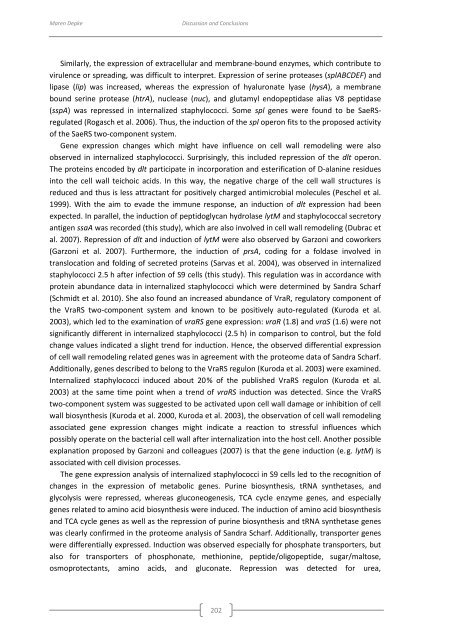genomewide characterization of host-pathogen interactions by ...
genomewide characterization of host-pathogen interactions by ...
genomewide characterization of host-pathogen interactions by ...
You also want an ePaper? Increase the reach of your titles
YUMPU automatically turns print PDFs into web optimized ePapers that Google loves.
Maren Depke<br />
Discussion and Conclusions<br />
Similarly, the expression <strong>of</strong> extracellular and membrane-bound enzymes, which contribute to<br />
virulence or spreading, was difficult to interpret. Expression <strong>of</strong> serine proteases (splABCDEF) and<br />
lipase (lip) was increased, whereas the expression <strong>of</strong> hyaluronate lyase (hysA), a membrane<br />
bound serine protease (htrA), nuclease (nuc), and glutamyl endopeptidase alias V8 peptidase<br />
(sspA) was repressed in internalized staphylococci. Some spl genes were found to be SaeRSregulated<br />
(Rogasch et al. 2006). Thus, the induction <strong>of</strong> the spl operon fits to the proposed activity<br />
<strong>of</strong> the SaeRS two-component system.<br />
Gene expression changes which might have influence on cell wall remodeling were also<br />
observed in internalized staphylococci. Surprisingly, this included repression <strong>of</strong> the dlt operon.<br />
The proteins encoded <strong>by</strong> dlt participate in incorporation and esterification <strong>of</strong> D-alanine residues<br />
into the cell wall teichoic acids. In this way, the negative charge <strong>of</strong> the cell wall structures is<br />
reduced and thus is less attractant for positively charged antimicrobial molecules (Peschel et al.<br />
1999). With the aim to evade the immune response, an induction <strong>of</strong> dlt expression had been<br />
expected. In parallel, the induction <strong>of</strong> peptidoglycan hydrolase lytM and staphylococcal secretory<br />
antigen ssaA was recorded (this study), which are also involved in cell wall remodeling (Dubrac et<br />
al. 2007). Repression <strong>of</strong> dlt and induction <strong>of</strong> lytM were also observed <strong>by</strong> Garzoni and coworkers<br />
(Garzoni et al. 2007). Furthermore, the induction <strong>of</strong> prsA, coding for a foldase involved in<br />
translocation and folding <strong>of</strong> secreted proteins (Sarvas et al. 2004), was observed in internalized<br />
staphylococci 2.5 h after infection <strong>of</strong> S9 cells (this study). This regulation was in accordance with<br />
protein abundance data in internalized staphylococci which were determined <strong>by</strong> Sandra Scharf<br />
(Schmidt et al. 2010). She also found an increased abundance <strong>of</strong> VraR, regulatory component <strong>of</strong><br />
the VraRS two-component system and known to be positively auto-regulated (Kuroda et al.<br />
2003), which led to the examination <strong>of</strong> vraRS gene expression: vraR (1.8) and vraS (1.6) were not<br />
significantly different in internalized staphylococci (2.5 h) in comparison to control, but the fold<br />
change values indicated a slight trend for induction. Hence, the observed differential expression<br />
<strong>of</strong> cell wall remodeling related genes was in agreement with the proteome data <strong>of</strong> Sandra Scharf.<br />
Additionally, genes described to belong to the VraRS regulon (Kuroda et al. 2003) were examined.<br />
Internalized staphylococci induced about 20 % <strong>of</strong> the published VraRS regulon (Kuroda et al.<br />
2003) at the same time point when a trend <strong>of</strong> vraRS induction was detected. Since the VraRS<br />
two-component system was suggested to be activated upon cell wall damage or inhibition <strong>of</strong> cell<br />
wall biosynthesis (Kuroda et al. 2000, Kuroda et al. 2003), the observation <strong>of</strong> cell wall remodeling<br />
associated gene expression changes might indicate a reaction to stressful influences which<br />
possibly operate on the bacterial cell wall after internalization into the <strong>host</strong> cell. Another possible<br />
explanation proposed <strong>by</strong> Garzoni and colleagues (2007) is that the gene induction (e. g. lytM) is<br />
associated with cell division processes.<br />
The gene expression analysis <strong>of</strong> internalized staphylococci in S9 cells led to the recognition <strong>of</strong><br />
changes in the expression <strong>of</strong> metabolic genes. Purine biosynthesis, tRNA synthetases, and<br />
glycolysis were repressed, whereas gluconeogenesis, TCA cycle enzyme genes, and especially<br />
genes related to amino acid biosynthesis were induced. The induction <strong>of</strong> amino acid biosynthesis<br />
and TCA cycle genes as well as the repression <strong>of</strong> purine biosynthesis and tRNA synthetase genes<br />
was clearly confirmed in the proteome analysis <strong>of</strong> Sandra Scharf. Additionally, transporter genes<br />
were differentially expressed. Induction was observed especially for phosphate transporters, but<br />
also for transporters <strong>of</strong> phosphonate, methionine, peptide/oligopeptide, sugar/maltose,<br />
osmoprotectants, amino acids, and gluconate. Repression was detected for urea,<br />
202

















